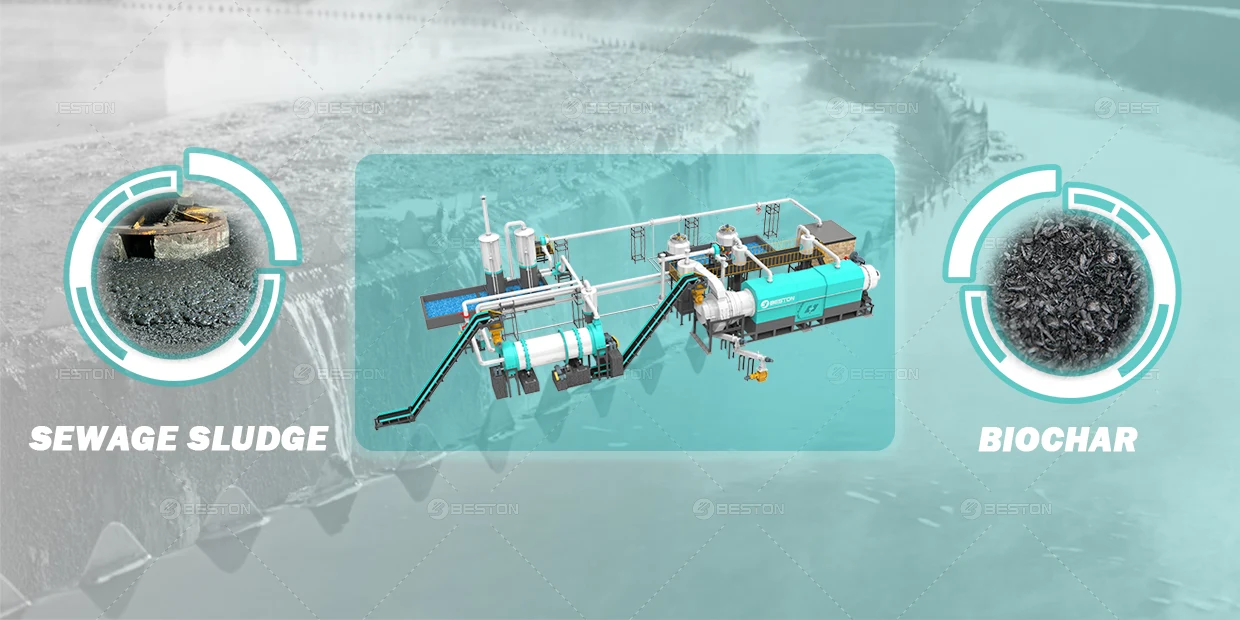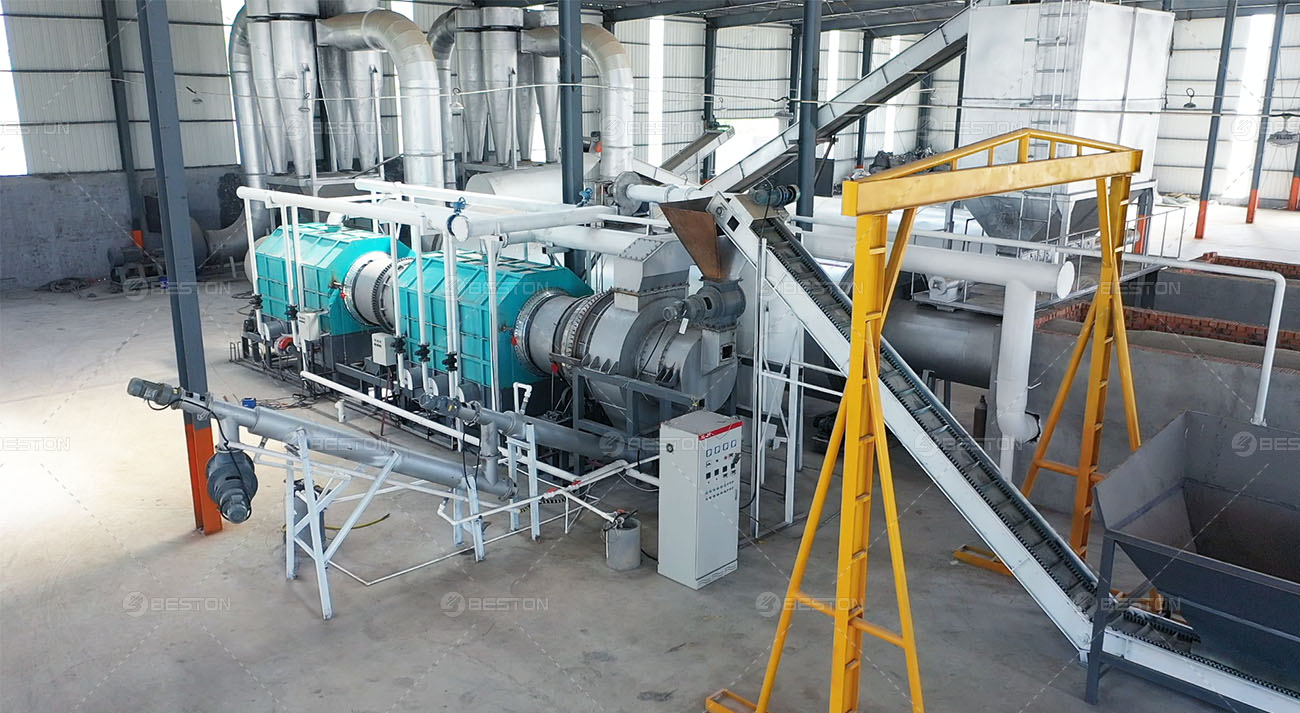Advantages of Sewage Sludge Carbonization Recovery Method
Sewage sludge carbonization is an advanced method of recovering valuable materials from sewage sludge, a by-product of wastewater treatment processes. This technique involves the thermal decomposition of sewage sludge at high temperatures in the absence of oxygen, resulting in the production of carbon-rich materials. The carbonization process offers several advantages, making it a significant method in waste management and resource recovery. This article explores the key benefits of utilizing a sewage sludge charcoal making machine for effective waste treatment and resource recovery.

Enhanced Resource Recovery
Conversion to Valuable Carbon Products
One of the primary advantages of sewage sludge carbonization is the transformation of waste sludge into valuable carbon products. The carbonization process yields biochar, a stable form of carbon that can be used in various applications. Biochar produced from sewage sludge can be employed as a soil amendment, helping to improve soil fertility and structure. Additionally, it can be utilized as a precursor for activated carbon production, which is essential for water purification and air filtration.
Reduction of Waste Volume
Sewage sludge carbonization significantly reduces the volume of waste. The process converts a substantial portion of the sludge into stable carbon, thereby minimizing the quantity of material that needs to be disposed of. This reduction in waste volume helps alleviate the burden on landfills and waste treatment facilities, contributing to more efficient waste management.
Environmental Benefits
Mitigation of Greenhouse Gas Emissions
The carbonization of sewage sludge mitigates greenhouse gas emissions by converting organic waste into a stable carbon form. Unlike untreated sewage sludge, which may decompose and release methane—a potent greenhouse gas—carbonized sludge produces minimal emissions. This reduction in greenhouse gas emissions contributes to climate change mitigation efforts and enhances the overall sustainability of waste management practices.
Decreased Pollution Risk
By transforming sewage sludge into carbon-rich products, carbonization reduces the risk of environmental pollution. Traditional disposal methods, such as landfilling or incineration, can lead to soil and water contamination or air pollution. Carbonization, however, stabilizes the waste and reduces the potential for leachate and other contaminants, thereby minimizing the environmental impact.
Economic Advantages
Cost-Effective Waste Management
The use of a sewage sludge treatment plant adopts carbonization technology offers economic benefits by providing a cost-effective alternative to traditional waste treatment methods. Carbonization reduces the need for expensive landfill space and costly waste disposal procedures. Additionally, the production of valuable by-products such as biochar and activated carbon can generate revenue streams, offsetting some of the operational costs associated with the process.
Value Addition through By-Products
Carbonization creates high-value by-products that can be monetized. Biochar, for instance, is in demand for agricultural and environmental applications due to its ability to enhance soil properties and sequester carbon. Activated carbon, derived from the carbonized sludge, is crucial for various industrial processes, including water and air purification. The sale of these by-products can provide additional financial incentives for implementing sewage sludge carbonization.
Technical and Operational Benefits
Efficient Processing
Sewage sludge carbonization is an efficient processing method that can handle large volumes of sludge. Modern carbonization machines are designed to operate continuously and manage varying sludge feedstocks effectively. The controlled environment within the carbonization unit ensures consistent product quality and high processing efficiency, making it a reliable solution for large-scale waste treatment operations.
Versatility of Feedstocks
The carbonization process is versatile and can accommodate different types of sewage sludge, including those with varying moisture content and organic composition. This adaptability makes it a suitable option for a wide range of wastewater treatment facilities, regardless of the specific characteristics of the sludge generated.
Low Operational Costs
The operational costs associated with sewage sludge carbonization are relatively low compared to other waste treatment methods. The process typically requires less energy than incineration and generates fewer emissions, leading to reduced compliance and mitigation costs. Additionally, the longevity and durability of carbonization equipment contribute to lower maintenance expenses over time.
Long-Term Sustainability
Carbon Sequestration
One of the most compelling advantages of sewage sludge carbonization is its role in carbon sequestration. The carbonized product, biochar, acts as a stable carbon sink, locking carbon away from the atmosphere for extended periods. This long-term sequestration of carbon contributes to reducing atmospheric CO2 levels and supports global efforts to combat climate change.
Circular Economy Contribution
Sewage sludge charcoal furnace aligns with principles of the circular economy by promoting resource recovery and waste minimization. By converting waste sludge into valuable products, the process supports a more sustainable approach to waste management. It reduces the reliance on virgin materials and encourages the reuse of waste products, contributing to a more circular and sustainable economic model.
Future Prospects
Technological Advancements
The field of sewage sludge carbonization is continually evolving, with ongoing research focusing on improving the efficiency and effectiveness of carbonization machines. Innovations in technology aim to enhance the quality of the carbonized products, increase processing capacity, and reduce operational costs. These advancements will further solidify the role of carbonization in modern waste management strategies.
Expanding Applications
As the demand for sustainable waste management solutions grows, the applications for carbonized sewage sludge products are likely to expand. Future research may explore new uses for biochar and activated carbon in various industries, such as construction, energy storage, and environmental remediation. Expanding the range of applications will enhance the economic viability and environmental benefits of sewage sludge carbonization.

Conclusion
Sewage sludge carbonization presents a compelling method for waste recovery, offering numerous advantages over traditional treatment methods. The process not only transforms waste sludge into valuable carbon products but also provides significant environmental and economic benefits. By reducing waste volume, mitigating greenhouse gas emissions, and creating high-value by-products, sewage sludge carbonization contributes to a more sustainable and efficient waste management system.
The continued development and adoption of sewage sludge carbonization technology will play a crucial role in advancing waste treatment practices and supporting environmental sustainability. As the technology evolves, its potential for improving waste management and resource recovery will only grow, making it a key component in the future of waste processing. Contact Beston China for more recycling options.